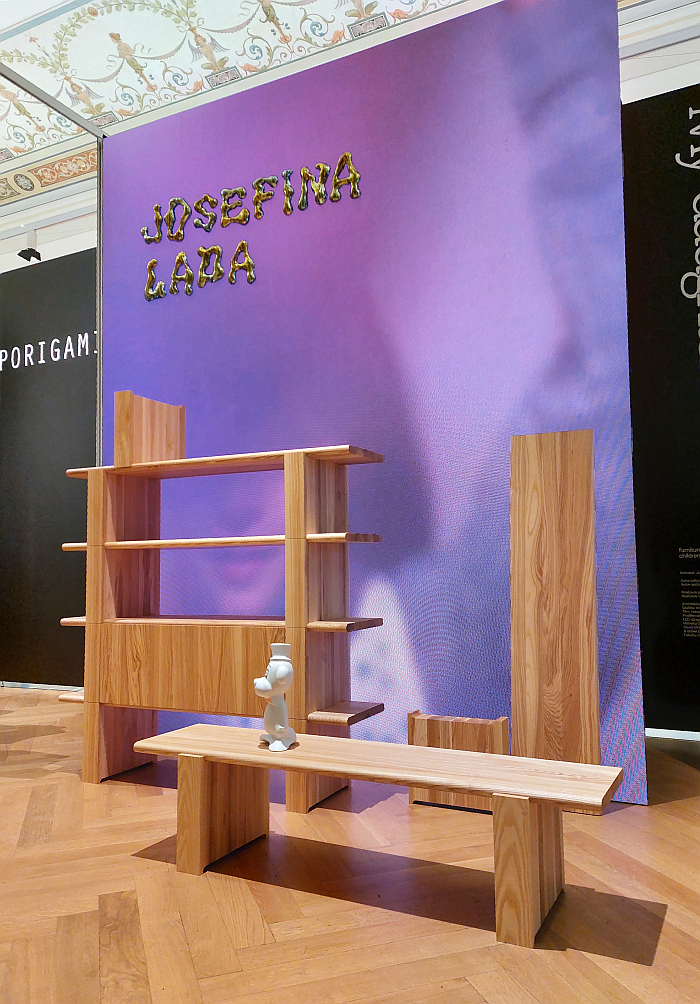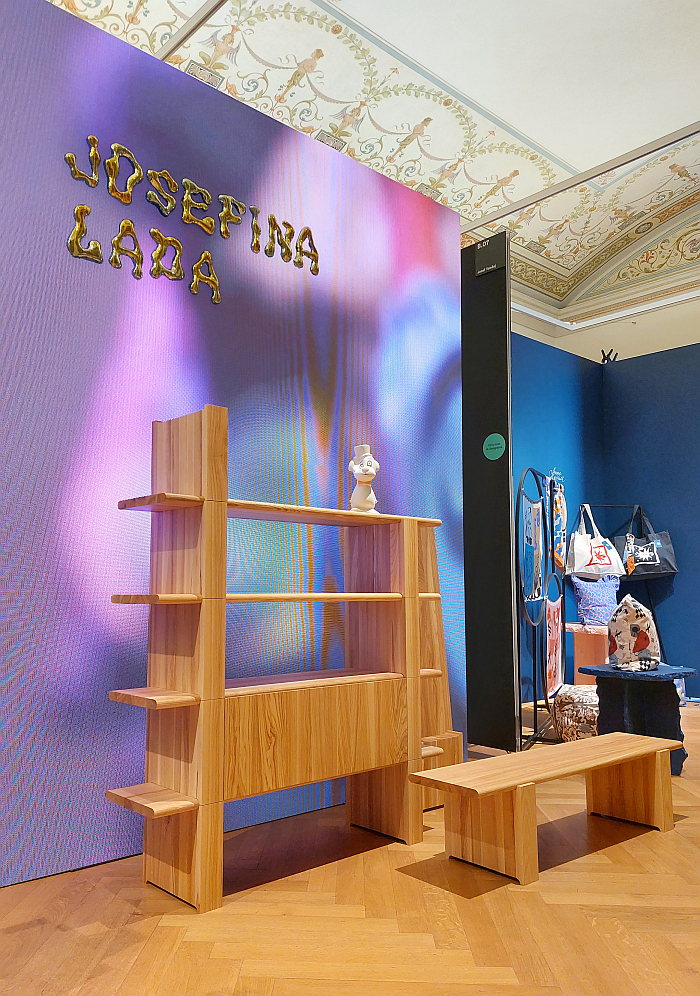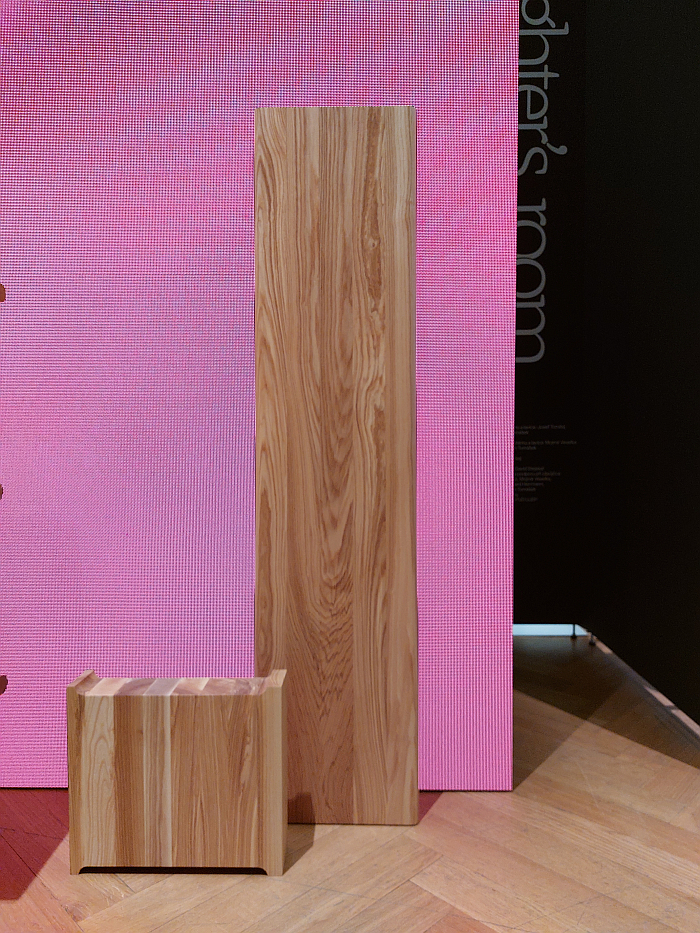
There is a much posed question in terms of chairs as to if we need ever more chairs. The answer is, we do. We certainly do; but, and as opined from A Chair and You at the Grassi Museum für Angewandte Kunst, Leipzig, we all do.
Similarly, at each and every design week or furniture fair we invariably ask ourselves if we need ever more sectional/modular shelving and storage systems, as we stand in front of another interpretation of the concept. In terms of shelving and storage we're much harder than we are with chairs, and often decide that we don't. But standing, and sitting, in front of Josef Tomšej's project My Daughter's Room at Designblok Prague 2024 we decided that we definitely do.
And that not only because of the visual ease and the intuitiveness of use; nor only because you can also employ it as bench and/or use part of it as bench that can be effortlessly stored away atop the stack when not in use thereby freeing up floor space as/when required; nor nor only because the vertical support elements can be freely placed to disrupt the quadraticness and create an individual visual, remembering of course the universal laws of statics. And not even because it already features a very satisfying, understated but ever present, drawer element that implies further neat additions are but a flash of inspiration away.
But on the one hand because standing, and sitting, in front of Josef's system at Designblok 2024 it, for us, effortlessly elucidated the urgent necessity of moving towards novel production and distribution systems in the furniture industry, was an impassioned cry for a move towards novel production and distribution systems in the furniture industry, for a move away from centralised production and international distribution to local production for local markets. A move that is, again for us, an unavoidable component of the global furniture industry addressing its great many irresponsibilities; a move contemporary and emerging technology not only actively facilitates but admonishes we make. And a move that requires a focus on, and concentrated development of, items of furniture responsive to and suitable for the novel realities.
Furniture such as Josef Tomšej's sectional/modular shelving and storage system.
It's shelving but can also be seating furniture: is one system with many functions.
It's universally applicable.
It's wood. It's not a secret industrial material, not a material known for the complexity of its processing: it's a readily available material that, with the correct tools, can be readily worked and processed. Thus while Josef and/or the licensing company can, arguably should, define which types and qualities of woods can, must, be used, local workshops can produce components of the system to order, according to Josef's design, as and when local dealers require them for local customers. An expression of that reality that, as the former editor of Form+Zweck Hein Köster once sagely noted in context of the decentral production of the EW 1192 by Horst Heyder, "distributing plans is cheaper than transporting finished products".1 And is also much more sustainable. Represents an environmentally, socially and economically responsible system, and repositioning, of the global furniture industry in local communities.
Whereby we are very much aware that when we make such statements without discussing such with the designers involved, much as here we haven't discussed this possibility with Josef, there is a risk that we are appropriating someone else's work for our arguments. And are also very much aware that in doing such we are potentially placing a designer's work in a context it wasn't created in or with which it is in agreement. That's not our intention, apologies if it comes across as that. For our part we're simply using a, the, work as an example to illustrate the changes we firmly believe the global furniture industry must make; it can't continue the way it is. Or not if it wants to have a world to supply furniture for. We need to re-imagine furniture production and distribution, need to re-imagine what furniture is, should be, and that very much involves designers and brands and retailers. And customers. We all have a part to play. As in all areas of society.
And on the other hand because the construction system is very clearly based on a widespread vernacular wood construction principle employed when whole tree trunks are used rather than planks and beams in the construction of buildings; a widespread vernacular system Josef has very neatly refined, and semi-industrialised, and linearly re-aligned, in order to enable his simple, intuitive, child friendly construction system, and thereby the easy aesthetic; but a vernacular basis which remains visible, which remains identifiable. And as such reminds of the relevance, coherence, beauty and instructiveness of vernacular in an age when we are all so clever and inventive. And for all reminds of the importance of increasingly listening to and learning from the vernacular as we get ever clever and more inventive. Which doesn't mean copying the vernacular, doesn't mean simply repeating the vernacular ad infinitum, ad nauseam, but does mean not rejecting it, means accepting it as a solution every bit as valid as those of our contemporary cleverness and inventiveness, and seeing where it take us.
And that's why we need Josef Tomšej's system. All of us, not just Josef's daughter. Daughters if we've correctly understood.
Although they are more than welcome to have as large a system as they want: their dad made it for them after all. You don't get much more local level production than that. We're all just profiting from that paternal act. Practically and conceptually, tangibly and intangibly.
As far as we can ascertain Josef Tomšej doesn't have a website, but he does an Instagram channel, or at least has set one up, more or less.... @dodo_bakula
And for all in or near Prague My Daughter's Room by Josef Tomšej can be experienced until Sunday September 6th at the Museum of Decorative Arts, 17. listopadu 2/2, Prague 1 as part of Designblok 2024. Full details can be found at www.designblok.cz


1Hein Köster, Die Erste Jahre, Form+Zweck, Vol. 11, Nr. 5, 1979 page 19